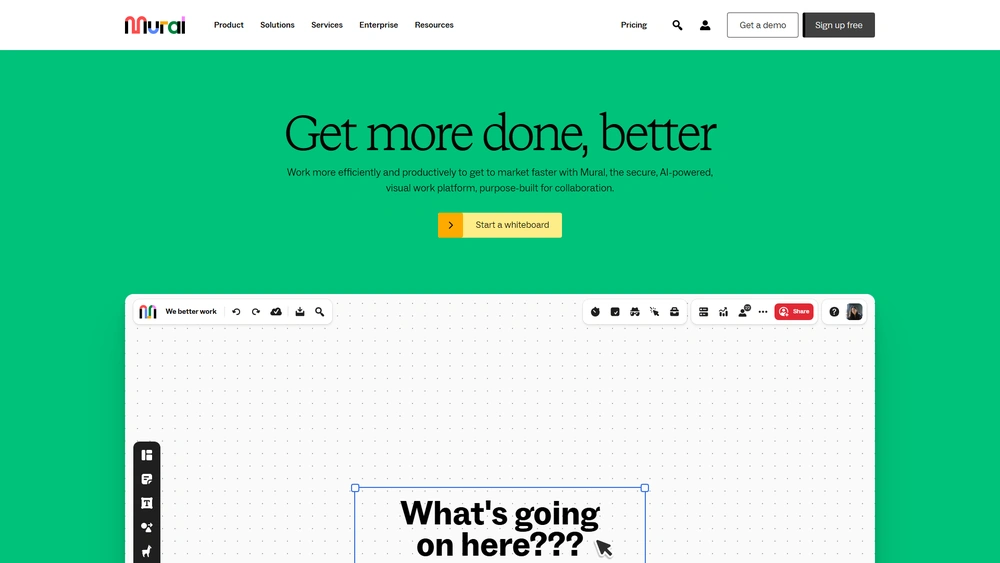Mural Overview & 2025 Industry Position
Mural is a visual collaboration platform designed to supercharge remote and hybrid teamwork through interactive digital whiteboards, brainstorming templates, and shared canvases. In 2025, Mural holds a strategic position in the rapidly growing enterprise collaboration space thanks to enhanced AI-driven facilitation features, embedded integrations with popular tools, and enterprise-grade scalability. As teams shift away from linear task management toward visual thinking and real-time ideation, Mural stands out as a cognitive collaboration layer that helps organizations innovate faster.
From Launch to 2025: Mural’s Journey
Founded in 2011 in Buenos Aires, Mural initially served design thinking teams needing visual brainstorming tools. Its turning points include:
- 2014: Launch of collaborative canvas model with multi-user support.
- 2016: Integration with Slack and Microsoft Teams.
- 2019: $23M Series A funding rounds accelerate R&D.
- 2020: Explosive growth during COVID-19 remote work shift.
- 2022: Launch of Mural’s Facilitation Superpowers™ for async brainstorms.
- 2024: Features like AI-powered idea clustering and sentiment mapping released.
2025 Thesis: Mural aims to be the connective tissue of hybrid collaboration by embedding intelligence, integrations, and inclusion into every team ritual.

Mural Key Features
From workshops to async planning, Mural’s core capabilities empower a new way to collaborate visually.
- Infinite Canvas: Large-scale whiteboard with sticky notes, shapes, connectors, and more.
- Facilitation Tools: Timer, voting, private mode, frames, and attention helpers.
- AI Assist: Group suggestions, idea expansions, and clustering using natural language cues.
- Templates: 300+ meeting-ready frameworks for sprint planning, retros, HMW exercises, etc.
- Enterprise Controls: SCIM provisioning, audit logs, and customizable permissions.
- Offline Mode: Recent update allows use during poor connections with autosync support.
Workflow & UX
Mural offers a low-friction UX optimized for collaboration across teams and time zones. Navigation is intuitive with drag-and-drop elements, mini-map orientation, and multi-user cursors. Accessibility features like real-time narration, color-blind optimized palettes, and keyboard navigation have seen strong improvements in the 2025 release. The mobile app includes canvas previews, quick commenting, and hybrid meeting support on the go. Multi-board projects simplify complex initiatives by unifying threads within a single dashboard.
Mural Pricing Analysis & Value Metrics
As of July 2025, Mural offers 4 main pricing tiers:
| Plan | Price/month | Included Features |
|---|---|---|
| Free | $0 | Up to 3 murals, basic templates, limited guests |
| Team | $14.99/user | Unlimited murals, AI ideation, third-party integrations |
| Business | $21.99/user | Advanced security, guest editing, shared team workspace |
| Enterprise | Custom | SCIM, compliance, SSO, success management |
While not the cheapest in its category, Mural’s workflow-centric tools, facilitation automation, and strong support justify its pricing for mid-to-large organizations and consultants leading workshops.
Competitive Landscape
| Platform | Best For | Notable Edge | Starting Price |
|---|---|---|---|
| Mural | Enterprises & consultants | Facilitation tools + templates + AI | $14.99/user |
| Figma FigJam | Design-centric teams | UX/UI alignment | $12/editor |
| Lucidspark | Enterprise systems | Data-diagram integration | $10/user |
| Miro | General brainstorming | App marketplace | $8/user |
Use Cases
Mural is used across sectors to visualize processes, align teams, and co-create. Common high-value scenarios include:
- Product and sprint planning workshops
- Design thinking in UX research sessions
- Consulting workshops with clients or internal stakeholders
- Strategic visioning at executive offsites
- Remote classroom or training facilitation
Mural Integrations
Mural connects with major tools to fit naturally into existing workflows:
- Slack & Microsoft Teams: Share murals, receive notifications, launch from meetings
- Zoom & Webex: Real-time collaboration within calls
- Atlassian Jira & Confluence: Sync boards with dev tasks
- Google Workspace & Microsoft 365: Embeds, SSO, and Drive/OneDrive syncing
- Notion & Asana: Embed murals in docs/project boards
Pros & Cons
- Pros: Seamless facilitation tools, smart AI features, scalable for large enterprises, strong integrations
- Cons: Higher cost than basic whiteboarding tools, some learning curve for first-time users, offline editing still limited
Pro Tip: Use Mural’s “Summon” feature to direct team attention live during high-stakes workshops—it’s a game-changer for facilitators.
Final Thoughts
Mural is built for facilitators, strategist teams, educators, and enterprise departments seeking high-engagement methodologies over traditional video calls or document exchanges. If you’re orchestrating complex planning or ideation and want every voice in the room—even asynchronously—Mural collaboration tools present a compelling advantage. The 2025 feature set solidifies it as more than a digital whiteboard—it’s a structured thinking environment.
Mural FAQ
Yes, Mural offers an education program granting free access to verified students and educators with full templates and collaboration features.
Yes, Mural now supports offline mode with automatic syncing once reconnected. It works best for editing recent boards.
Mural uniquely focuses on workshop facilitation. Its tools like timers, idea voting, and integrated templates are designed for high-structure sessions versus passive note capture.
Yes, depending on your plan. Business and above include guest editing links for collaborators without full accounts.
Enterprise plans support hundreds of concurrent users with real-time presence features. Performance may vary by network.